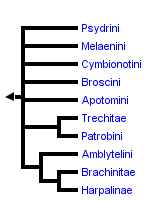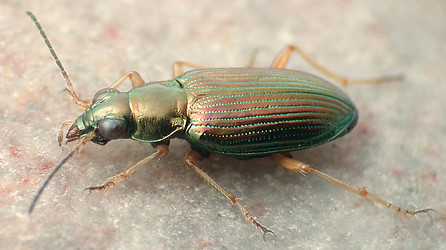Carabidae Conjunctae
David R. Maddison


This tree diagram shows the relationships between several groups of organisms.
The root of the current tree connects the organisms featured in this tree to their containing group and the rest of the Tree of Life. The basal branching point in the tree represents the ancestor of the other groups in the tree. This ancestor diversified over time into several descendent subgroups, which are represented as internal nodes and terminal taxa to the right.

You can click on the root to travel down the Tree of Life all the way to the root of all Life, and you can click on the names of descendent subgroups to travel up the Tree of Life all the way to individual species.
For more information on ToL tree formatting, please see Interpreting the Tree or Classification. To learn more about phylogenetic trees, please visit our Phylogenetic Biology pages.
close boxCharacteristics
This informal group of carabids is characterized by a derived feature of their middle coxal cavities, in which the mesosternum and metasternum surround the mesocoxae, forming both the mesal and lateral walls of the coxae. Such mesocoxal cavities are called "conjunct", and they give this group its name. In contrast, most carabids outside of this group have disjunct mesocoxal cavities, in which the the lateral wall of the cavity is formed in part by the mesepimeron (the sterna thus being disjunct on the lateral wall of the cavity). Outside of the Carabidae Conjunctae, the only carabids with conjunct mesocoxal cavities are the Notiophilini and some Paussini (Kavanaugh and Nègre, 1982; Beutel, 1991).In addition, the posterior edge of the metepimeron of these carabids is lobed, and partly overlaps the first visible abdominal sternum.
References
Maddison, D.R., M.D. Baker, and K.A. Ober. 1999. Phylogeny of carabid beetles as inferred from 18S ribosomal DNA (Coleoptera: Carabidae). Systematic Entomology, 24:103-138.
Title Illustrations

| Scientific Name | Bembidion confusum |
|---|---|
| Location | USA: Iowa: Manchester |
| Specimen Condition | Dead Specimen |
| Image Use |
 This media file is licensed under the Creative Commons Attribution License - Version 3.0. This media file is licensed under the Creative Commons Attribution License - Version 3.0.
|
| Copyright |
© 2004 David R. Maddison

|
About This Page
David R. Maddison

Oregon State University
Correspondence regarding this page should be directed to David R. Maddison at
Page copyright © 2012 David R. Maddison
 Page: Tree of Life
Carabidae Conjunctae.
Authored by
David R. Maddison.
The TEXT of this page is licensed under the
Creative Commons Attribution License - Version 3.0. Note that images and other media
featured on this page are each governed by their own license, and they may or may not be available
for reuse. Click on an image or a media link to access the media data window, which provides the
relevant licensing information. For the general terms and conditions of ToL material reuse and
redistribution, please see the Tree of Life Copyright
Policies.
Page: Tree of Life
Carabidae Conjunctae.
Authored by
David R. Maddison.
The TEXT of this page is licensed under the
Creative Commons Attribution License - Version 3.0. Note that images and other media
featured on this page are each governed by their own license, and they may or may not be available
for reuse. Click on an image or a media link to access the media data window, which provides the
relevant licensing information. For the general terms and conditions of ToL material reuse and
redistribution, please see the Tree of Life Copyright
Policies.
- Content changed 06 January 2012
Citing this page:
Maddison, David R. 2012. Carabidae Conjunctae. Version 06 January 2012 (under construction). http://tolweb.org/Carabidae_Conjunctae/66/2012.01.06 in The Tree of Life Web Project, http://tolweb.org/







 Go to quick links
Go to quick search
Go to navigation for this section of the ToL site
Go to detailed links for the ToL site
Go to quick links
Go to quick search
Go to navigation for this section of the ToL site
Go to detailed links for the ToL site